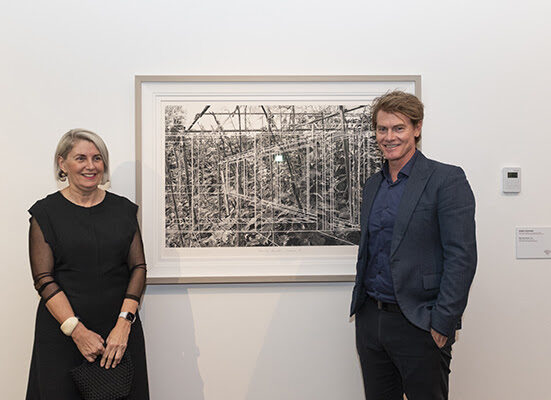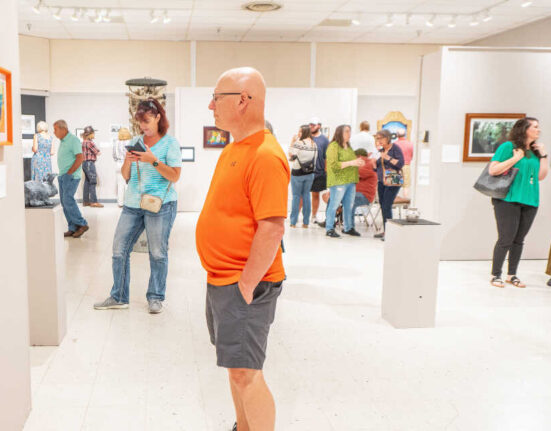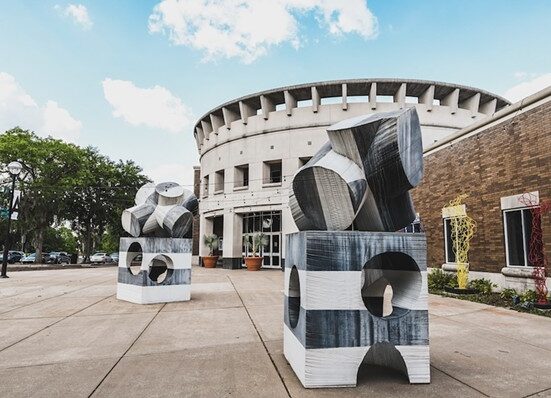Pia Johnson is a photographer and visual artist whose work explores notions of diaspora and otherness as it relates to her background as Chinese Malaysian and Italian Australian.
“I spent a lot of time with my grandparents in their suburban brick home,” says Johnson, who has been a finalist in the National Photographic Portrait Prize, the Olive Cotton Award and the Bowness Prize. “There was shag pile carpet and they had these Chinese–Malaysian things but they were British.” To make her 2020 series Mooramong Green, which showed in 2022 at Bundoora Homestead, she portrayed herself in a mansion owned by Victorian pastoralists.
In her new exhibition, Re-Orient: Reclaiming Spaces, Redefining Stories, now on show at Melbourne’s Immigration Museum, she presents self-portraits that see her occupy the grand spaces of Old Customs House. The work uses colonial architecture to ask questions about who gets to belong. Johnson chose to talk about Disorient by the renowned visual artist and filmmaker Fiona Tan, who was born in Indonesia and lives in Amsterdam. The 2009 work, which draws on the story of Marco Polo, the Venetian merchant who journeyed to China in the 13th century, is a study of cultural dissonance – and how the imperial past set the stage for the modern world.
What struck you about Disorient the first time you saw it?
I saw Disorient at an international gallery in Italy. There were multiple rooms and headsets and you would click into a soundtrack. It felt very personal but very encompassing. You hear the narrative, you hear the voiceover and it is quite incredible. To me, Disorient is lush and gold and romantic and beautiful. Then you have the archival footage. It is a really interesting dissonance between the two.
That is what I love about Disorient. It speaks to Marco Polo and discovering the “Orient” – but your experience of it is disorienting. You are taking in information that doesn’t seem to line up. With a lot of Fiona Tan’s work, it is so visually rich and layered that you don’t have an instant reaction. You have to take your time.
Tan’s work often reflects the tensions inherent in transcultural identity. But it’s increasingly about time – the relationship between memory and history. What did her language open up for you?
I first discovered Fiona Tan through the work Saint Sebastian (2001) at the Melbourne Festival. As her career has progressed, I realise that she’s left some of that [original] language behind and really developed a new way of thinking about her work, which is in the realm of memory and time. Her work History’s Future (2015) is about memory and time, memory and history – because the main character of that work is disoriented. So as an audience, you question her journey.
I recognise some of her characters and can relate to that. But she has really deep research methodologies. She spends a lot of time in residencies and in archives and then she creates these beautiful artworks that are contemplative but engaging.
I am trying to render the invisible all the time. The things that have not stayed in the history books because the [subject] is a minority or female or they are a migrant. And by placing myself into images it is partly a practical thing – but also about trying to represent that [anyone] could be in these images. The East–West negotiation could be everyone’s negotiation.

I feel like your work, like Tan’s, is really about experiences that haven’t been documented or haven’t been part of official history. In so many ways, migrants aren’t seen as credible witnesses.
At the Immigration Museum, part of my residency was trying to read about stories of migrants from the gold rush to now. They made amazing contributions to small towns across Australia or cities – but [often] because of World War I and World War II, they were let go of. Everything that they had was destroyed. And they never recovered. They were eternally a migrant. I borrow a term from Fiona called “perpetual foreigner” – and I love that term. She was born in Indonesia and then she stayed over in the Netherlands. She wasn’t part of anything. I think you learn a bit more about what it means to be human through Fiona’s work.
The idea of being a perpetual foreigner is interesting: the sense that it doesn’t matter what you do or what you have, you are always “other”.
At airports, I always get stopped. [On one occasion] I unpacked everything, and no one helped me. And then I had to take the drug test. Because people can’t work out what you are by just your surface, they go, “Ooh you must be dangerous.” It is those kinds of markers that you as perpetual foreigner take on board. What would it be like if you didn’t have that?
What would it be like to move through the world in a frictionless way? Disorient evokes a spatial orientation – the West’s relationship to the East. In the work, one screen shows footage from places in Asia and the Middle East. There are people cycling on busy roads, still lifes of objects: rugs, statues, lanterns. On the other screen, there are shots of war, bombings, rubble that hints at the way these imperial legacies unfold in the modern day.
My grandparents were from Singapore and Malaysia, colonised by the British. They did all these Western things that were peculiar [to me]. My Italian side came much earlier to Melbourne. The stories my grandmother talks about evoke awful racial hate. Being spat on, having to walk in the gutter. When I look at Fiona’s work, these things are all still holding across time. Some of the atrocities that are happening across the world, what we are seeing now is being censored: images of war, Ukraine or Gaza. But there are narratives that we are being fed to smooth them over, to not see the human cost.
It sounds like you became aware of these narratives early.
I remember learning about World War II [at school] in Melbourne. Everyone was talking about the Holocaust and these important, terrible events that happened. And I said, “My grandmother was in Singapore, she was part of the Fall of Singapore.” And people were like, “What’s that?” Singapore is so much closer. We don’t get taught about that side of the war. I think this is what Fiona does. She finds these incredible stories and she articulates them in a creative medium, like in her film she has called Nellie (2013) [about Rembrandt’s illegitimate daughter Cornelia]. I think Fiona Tan has this incredible ability to show us things that we haven’t seen before. I am trying to make work from the same impulse.
Disorient was presented in the Dutch pavilion in Venice. She was clever in placing it there. She made sure that we saw the devastation of war on those screens. For my work Re-Orient, there are the visual optics of this big white building in Melbourne. They have whitewashed everything to be grand and austere, built on gold rush money. But it was this site of not allowing people to enter. Of giving people these ridiculous dictation tests. If you relate that back to Disorient, it is about these two sides of the same coin. This grandiose, rose-coloured way we want to imagine empires. And then about showing how it happens. I think we are trying to bring back context and evidence. If we can actually provide new ways of understanding that history as artists, it is such a wonderful, privileged, noble thing.
This article was first published in the print edition of The Saturday Paper on
April 13, 2024 as “Pia Johnson”.
For almost a decade, The Saturday Paper has published Australia’s leading writers and thinkers.
We have pursued stories that are ignored elsewhere, covering them with sensitivity and depth.
We have done this on refugee policy, on government integrity, on robo-debt, on aged care,
on climate change, on the pandemic.
All our journalism is fiercely independent. It relies on the support of readers.
By subscribing to The Saturday Paper, you are ensuring that we can continue to produce essential,
issue-defining coverage, to dig out stories that take time, to doggedly hold to account
politicians and the political class.
There are very few titles that have the freedom and the space to produce journalism like this.
In a country with a concentration of media ownership unlike anything else in the world,
it is vitally important. Your subscription helps make it possible.







